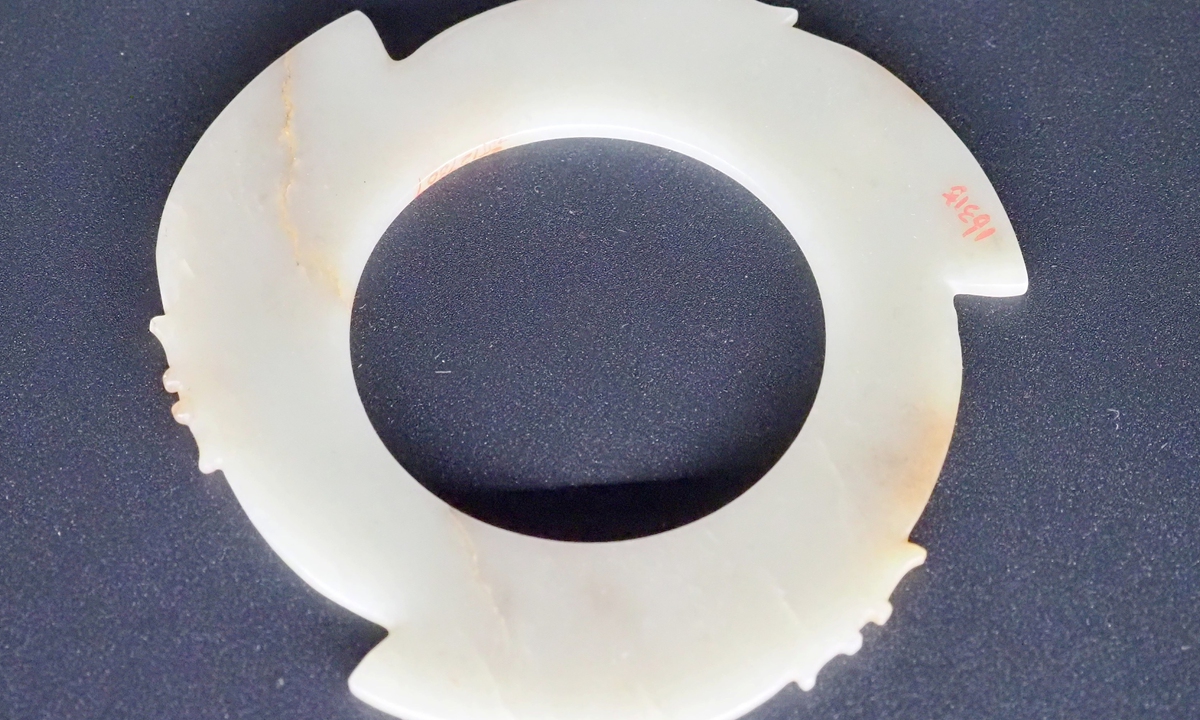
A jade piece belongs to the Lingjiatan culture Photo: IC
An exhibition of jade artifacts from the Lingjiatan relics site in Hanshan county, East China's Anhui Province, recently opened at The Palace Museum in Beijing. More than 90 percent of the 399 items on display, such as jade spoons from the Neolithic period and a newly unearthed jade axe, are being displayed for the first time.
"The Lingjiatan site dates back 5,800 to 5,300 years ago. It is regarded as one of the three major prehistoric jade cultural centers, alongside the Hongshan and the Liangzhu cultures," said Xu Lin during an interview with Beijing Daily. Xu is a research curator at the Palace Museum and one of the exhibition's curators.
"These exhibits, with their advanced jade craftsmanship, mysterious religious beliefs, and open cultural exchanges, provide concrete evidence of the 5,000-plus years of Chinese civilization," Xu noted.
The newest item in the exhibition is the gold medal from the 2022 Beijing Winter Olympics. Displayed alongside it is the inspiration for its design - a double jade disk from the Liangjiatan site. The surface of the disk was polished to a glossy finish, with a hollow space between the inner and outer rings. Each of the sides of the outer ring has four small holes, reflecting the intricate craftsmanship of the period, according to the Beijing Daily.
Among the most significant pieces on display is a jade wild pig. This pig features a protruding snout, with two clearly visible nostrils, and curved tusks.
"There are no signs of human modification from the neck to the tail," Xu said. "It is the largest and heaviest jade carving from this era discovered in China, and it is believed to possibly have had a symbolic or tomb-guarding function."
"Some experts speculate that ancient Chinese in the area regarded pigs as symbols of wealth. Including this jade pig, all the exhibits have undergone non-destructive scientific analysis to confirm their jade composition," Xu noted. Although the purposes of many exhibits remain uncertain and the meanings of their designs are open to interpretation, artisans of the time had a strong preference for animal motifs.
According to Xu, it is currently hypothesized that some of the exhibits were ritual objects used in sacrificial ceremonies, reflecting ancient Chinese people's belief in the spiritual essence of all things, their primitive religious views, and their highly imaginative creative spirit.
Six complete jade human figures have been unearthed at the Lingjiatan site, three in standing positions and three sitting. All of them feature square faces, with diagonal patterned belts at the waist and varying numbers of bracelets on their arms. The figures have solemn expressions, with their arms pressed to their chest and fingers spread apart, resembling a gesture of respect toward deities. Some scholars speculate that these may represent the shamans of the high-ranking aristocracy at Lingjiatan.
Some of the more than 5,000-year-old jade artifacts appear almost like "time travelers," displaying a striking modern aesthetic. The Lingjiatan jade dragon is curled in a circle with its head and tail joined together. With a flat body, the dragon's head protrudes with two horns extending above it and its ears, mouth, nose, and eyes outlined in fine lines. Seventeen diagonal lines are engraved around the outer edge of the body, forming the dragon's scales. This is the oldest jade dragon with horns and scales discovered to date.
"Over 5,000 years ago was a critical period in the formation of Chinese civilization," Xu noted. "As an important archaeological discovery influenced by jade culture during the Neolithic era, the Lingjiatan site has opened the door to exploring and reflecting on the origins of Chinese civilization."
Global Times




